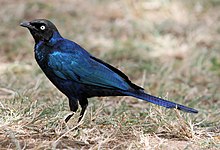Long-tailed gloss star
| Long-tailed gloss star | ||||||||||||
|---|---|---|---|---|---|---|---|---|---|---|---|---|

Long-tailed star in youth dress |
||||||||||||
| Systematics | ||||||||||||
|
||||||||||||
| Scientific name | ||||||||||||
| Lamprotornis caudatus | ||||||||||||
| ( Statius Müller , 1776) |
The long-tailed gloss star ( Lamprotornis caudatus ) is an African species of bird from the starling family . It has the metallic, shiny plumage and a very long tail that is typical for the genus of the genus of the actual glossy starlings ( Lamprotornis ). The species inhabits the savannahs of the southern Sahel zone as well as parks, gardens and farmland with sufficient trees.
features
Physique and plumage
Males have a wing length of 182-197 mm, their tail measures 290-335 mm. The beak is 27–29 mm long, the barrel bone 40–46 mm. Females are slightly smaller: their wing length is 168-184 mm, the tail length 290-335 mm. The beak measures 26–29 mm, the barrel bone 39–44 mm. The maximum body length of the long-tailed gloss star is 54 cm, with up to 34 cm on the tail. There is no gender-specific information on weight, it is between 103 and 133 g. The flexible, resilient tail is strongly tiered: the middle pair of feathers is four times as long as the outermost.
Males have - with the exception of the soot-black reins and ear covers - bronze-green head plumage. The neck, sides of the neck, shoulders, and back are shiny green; The rump and upper tail-coverts show a rich, glossy blue hue. The upper side of the control feathers is finely banded dark on a shimmering violet background, the lower side is black-brown. With the exception of the outermost pair of control springs, the control springs have a blue border. The throat and upper chest show the same shimmering green as the top of the body. A shiny blue stretches across the lower chest and flanks, which turns into a bronze purple on the belly. Under tail-coverts and leg fletching are soot-brown with a blue sheen. The wings are tinted black, on the upper side the tips and outer flags are shimmering green. Umbrella feathers , thumb feathers and upper wing coverts show a shiny green color. Large and medium arm covers have velvet black tips, forearm covers and armpit feathers are soot-brown with a green sheen. The bill and legs are black, the iris is milky white. Females and males show no clear differences in terms of coloration. However, smaller individuals (mostly females) tend to have a green shimmer and lighter head plumage, while larger individuals (mostly males) tend to have a purple sheen.
Birds in juvenile plumage differ from adult primarily through the wholly rußbraunen head and its green back and rump, and the green color turns less tired and pale than in adult animals. The upper tail coverts of young long-tailed starlings are blue and purple, the underside of the body soot-brown with a slight green shimmer on the chest. The iris is light yellow.
Flight image
The long-tailed gloss star flies with deep, powerful wing beats. The long tail and rounded wings are characteristic features in the field.
Vocalizations
The typical call of the long-tailed gloss star is a high-pitched , rattling chrrrrrijo or chrrrriljo .
Habitat and Distribution

The long-tailed gloss star is native to West , East and Central Africa. The distribution area extends along the southern Sahel zone and the bordering savannah regions from Senegal eastwards to the northern Sudanese Nile, with parts of Benin , Burkina Faso , Cameroon , the Central African Republic , Chad , the Ivory Coast , Gambia , Ghana , Guinea , Mauritania , Malis , Includes Nigeria , Senegal and Togo . As a migrant, the species is also found sporadically in Sierra Leone . The long-tailed gloss star prefers thorn bush and acacia savannas as well as heather areas.
Way of life
Long-tailed starlings are very sociable birds that occur in groups of up to 100 individuals. They often mimic the voices of other birds. Your warning calls sound loud and shrill. They are not afraid of people and often live near settlements.
Reproduction
During the breeding season , the pairs withdraw to build nests. The spherical nests are usually created in tree hollows or holes. Both sexes are involved in nest building, breeding and the protection of the young birds. The clutch usually consists of two to four eggs, which are bluish-gray in color. The breeding season averages 15 days. After hatching, the young birds are fed with insects and their larvae. The birds leave the nest after 18 to 24 days.
Systematics

The long-tailed gloss star is part of the Lamprotornis genus in a family group with four other species, all of which have very long and finely banded tails. Its sister species is the tail gloss star ( L. purpuroptera ).
| Lamprotornis |
|
||||||||||||||||||||||||
|
|
Existence and endangerment
There is no reliable information on the size of the world population, but the species is considered common in most of its range and the population as stable. The long-tailed star is therefore classified by the IUCN as not endangered (“least concern”).
literature
- Leslie H. Brown , Emil K. Urban , Kenneth B. Newman (Eds.): The Birds of Africa. Volume 6: Picathartes to Oxpeckers. Academic Press, 2000, ISBN 0-12-137306-1 , pp. 593-614.
- Clive Barlow, Tim Wacher: A Field Guide to Birds of the Gambia and Senegal. Pica Press, Hong Kong 1997, ISBN 0-300-07454-9 .
- Irby J. Lovette, Dustin R. Rubenstein: A Comprehensive Molecular Phylogeny of the Starlings (Aves: Sturnidae) and mockingbirds (Aves: Mimidae): Congruent mtDNA and Nuclear Trees for a Cosmopolitan Avian Radiation. In: Molecual Genetics and Evolution. 44 (3), 2007, doi : 10.1016 / j.ympev.2007.03.017 , pp. 1031-1056.
Web links
- Lamprotornis caudatus in the endangered Red List species the IUCN 2011. Posted by: BirdLife International, 2009. Accessed July 12, 2011th
Individual evidence
- ↑ a b c d e Brown et al. 2000 , p. 613.
- ↑ Lovett & Rubenstein 2007 , p. 1024.
